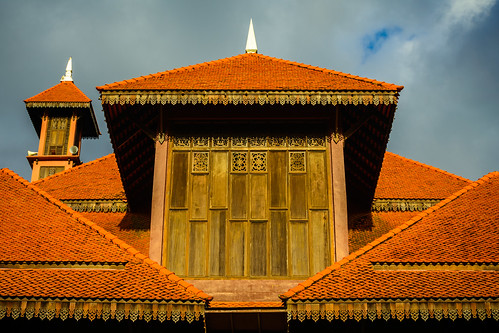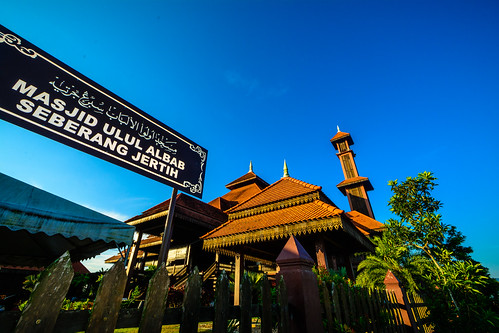The Ulul Albab Mosque | A modern timber mosque featuring vernacular architectural style
This mosque does not fall into heritage building category yet as it is a modern building. The mosque was built in 2009 and its construction was completely finished in 2011.
However I decided to feature this mosque in this blog because it is kind of special building that should be introduced to the world..
One of the special factors that compelled me to blog about this mosque is it is the most prominent landmark of my kampung (hometown), Kampung Seberang Jerteh. The mosque is strategically located at the corner of the Kuala Terengganu – Kota Bharu main road and the road to Kuala Besut, a fishing port and the departure point for boats to the Perhentian Islands. The mosque is situated approximately 1km away from Jerteh, the main commercial town of Besut district. It also serves as one of the attractions of Jerteh town besides the town’s main mosque, The Hadhari Mosque.
Upon its completion in 2011 it was simply known as Masjid Kayu Seberang Jerteh (The Timber Mosque of Seberang Jerteh). Only after the mosque was officially opened by the Sultan of Terengganu, Sultan Mizan Zainal Abidin, on 24 February 2012, was it renamed The Ulul Albab Mosque. It was built on a site of 0.2 hectare which was previously occupied by an old mosque built in the 60s. The cost of construction of this timber mosque was said to have amounted to RM12.3 million.
As of today it is regarded as the largest timber mosque in Malaysia. The architecture of this majestic mosque especially its pyramidal roof was inspired by the traditional design of the Nusantara mosques mainly based on the Kampung Laut Mosque of Tumpat, Kelantan – one of the oldest mosques in Malaysia.
The 3-tiered pyramidal roof with steep slope was designed as such to ensure it drains rainwater quickly to prevent damage to the timber structure underneath considering heavy rainfall in Terengganu especially during monsoon season at the year end.
Between the roof levels there are window-shaped vents for airflow and sunlight to enter providing comfort to the worshippers inside the prayer hall. The mosque's prayer hall has 12 main entrances and there are six staircases to access the prayer hall from the ground.
Another special feature of this mosque is its roof which uses Singgora roof tiles - the traditional roof tiles are made of clay and said to have originated from Singgora (now Sonkhla, Thailand). It was common for vernacular timber Malay houses in Kelantan and Terengganu to use Singgora roof tiles in yesteryear but it is becoming very rare now. The beauty of this roof tile is when the pieces are tiled they resemble fish scales from the outside. And since it is made of clay, the roof tiles keep the interior of the building cool.
The firm entrusted to build this mosque was Mira Murni Sdn Bhd. According to its CEO, Kamarulazmi Hamat, the main structure of this 3-storey mosque including its main columns and floor were made of concrete but covered with timber while the rest of the structure comprises 90% Chengal (Neobalanocarpus heimii) timber and the remaining 10% are nyatuh and bala timber (all tropical hard wood).
The ground floor of this 3-storey mosque is reserved as a community hall while the first floor is where the main prayer hall is that can accommodate approximately 1500 worshippers. The second floor which is also the top floor serves as the library and also a reserved prayer hall. The reserved prayer hall is normally open only during Eid prayer when the crowd is bigger than usual.
Besut is well known to have produced highly skillful wood carvers. This timber mosque is adorned with masterful wood carving produced by one of the famous master wood carvers of Besut, Wan Mustafa Wan Su (affectionately known as Wan Po).
Arabesque and flower motifs, Terengganu songket motifs as well as fine carvings of Arabic calligraphies and Qur’anic verses are featured throughout the building produced by Wan Po.
The Ulul Albab Mosque was the brainchild of Dato Seri Idris Jusoh who was the Terengganu Menteri Besar (chief minister) from 2004 to 2008. He also hails from Kampung Seberang Jerteh.
Do enjoy more pictures of The Ulul Albab Mosque in my Flickr site here.
However I decided to feature this mosque in this blog because it is kind of special building that should be introduced to the world..
One of the special factors that compelled me to blog about this mosque is it is the most prominent landmark of my kampung (hometown), Kampung Seberang Jerteh. The mosque is strategically located at the corner of the Kuala Terengganu – Kota Bharu main road and the road to Kuala Besut, a fishing port and the departure point for boats to the Perhentian Islands. The mosque is situated approximately 1km away from Jerteh, the main commercial town of Besut district. It also serves as one of the attractions of Jerteh town besides the town’s main mosque, The Hadhari Mosque.
Upon its completion in 2011 it was simply known as Masjid Kayu Seberang Jerteh (The Timber Mosque of Seberang Jerteh). Only after the mosque was officially opened by the Sultan of Terengganu, Sultan Mizan Zainal Abidin, on 24 February 2012, was it renamed The Ulul Albab Mosque. It was built on a site of 0.2 hectare which was previously occupied by an old mosque built in the 60s. The cost of construction of this timber mosque was said to have amounted to RM12.3 million.
As of today it is regarded as the largest timber mosque in Malaysia. The architecture of this majestic mosque especially its pyramidal roof was inspired by the traditional design of the Nusantara mosques mainly based on the Kampung Laut Mosque of Tumpat, Kelantan – one of the oldest mosques in Malaysia.
 |
| The front view of the Ulul Albab Mosque |
The 3-tiered pyramidal roof with steep slope was designed as such to ensure it drains rainwater quickly to prevent damage to the timber structure underneath considering heavy rainfall in Terengganu especially during monsoon season at the year end.
Between the roof levels there are window-shaped vents for airflow and sunlight to enter providing comfort to the worshippers inside the prayer hall. The mosque's prayer hall has 12 main entrances and there are six staircases to access the prayer hall from the ground.
Another special feature of this mosque is its roof which uses Singgora roof tiles - the traditional roof tiles are made of clay and said to have originated from Singgora (now Sonkhla, Thailand). It was common for vernacular timber Malay houses in Kelantan and Terengganu to use Singgora roof tiles in yesteryear but it is becoming very rare now. The beauty of this roof tile is when the pieces are tiled they resemble fish scales from the outside. And since it is made of clay, the roof tiles keep the interior of the building cool.
 |
| Notice the Singgora roof tiles which resemble fish scales |
The firm entrusted to build this mosque was Mira Murni Sdn Bhd. According to its CEO, Kamarulazmi Hamat, the main structure of this 3-storey mosque including its main columns and floor were made of concrete but covered with timber while the rest of the structure comprises 90% Chengal (Neobalanocarpus heimii) timber and the remaining 10% are nyatuh and bala timber (all tropical hard wood).
The ground floor of this 3-storey mosque is reserved as a community hall while the first floor is where the main prayer hall is that can accommodate approximately 1500 worshippers. The second floor which is also the top floor serves as the library and also a reserved prayer hall. The reserved prayer hall is normally open only during Eid prayer when the crowd is bigger than usual.
Besut is well known to have produced highly skillful wood carvers. This timber mosque is adorned with masterful wood carving produced by one of the famous master wood carvers of Besut, Wan Mustafa Wan Su (affectionately known as Wan Po).
Arabesque and flower motifs, Terengganu songket motifs as well as fine carvings of Arabic calligraphies and Qur’anic verses are featured throughout the building produced by Wan Po.
The Ulul Albab Mosque was the brainchild of Dato Seri Idris Jusoh who was the Terengganu Menteri Besar (chief minister) from 2004 to 2008. He also hails from Kampung Seberang Jerteh.
 |
| The north side of the gate |
 |
| One of the six staircases, each having songket motifs on its handrails |
 |
| The mosque's single minaret |
 |
| The tall window of the mosque |
 |
| The Ulul Albab Mosque in the early morning |
Do enjoy more pictures of The Ulul Albab Mosque in my Flickr site here.

ok
ReplyDelete